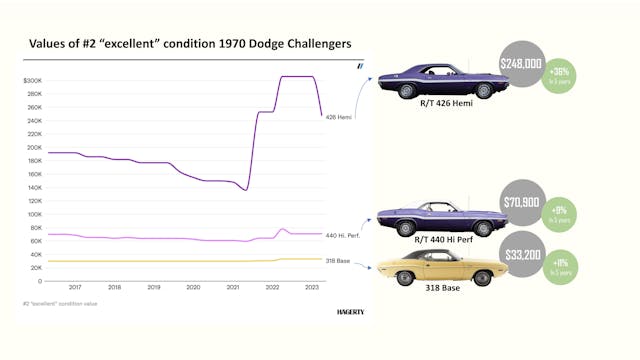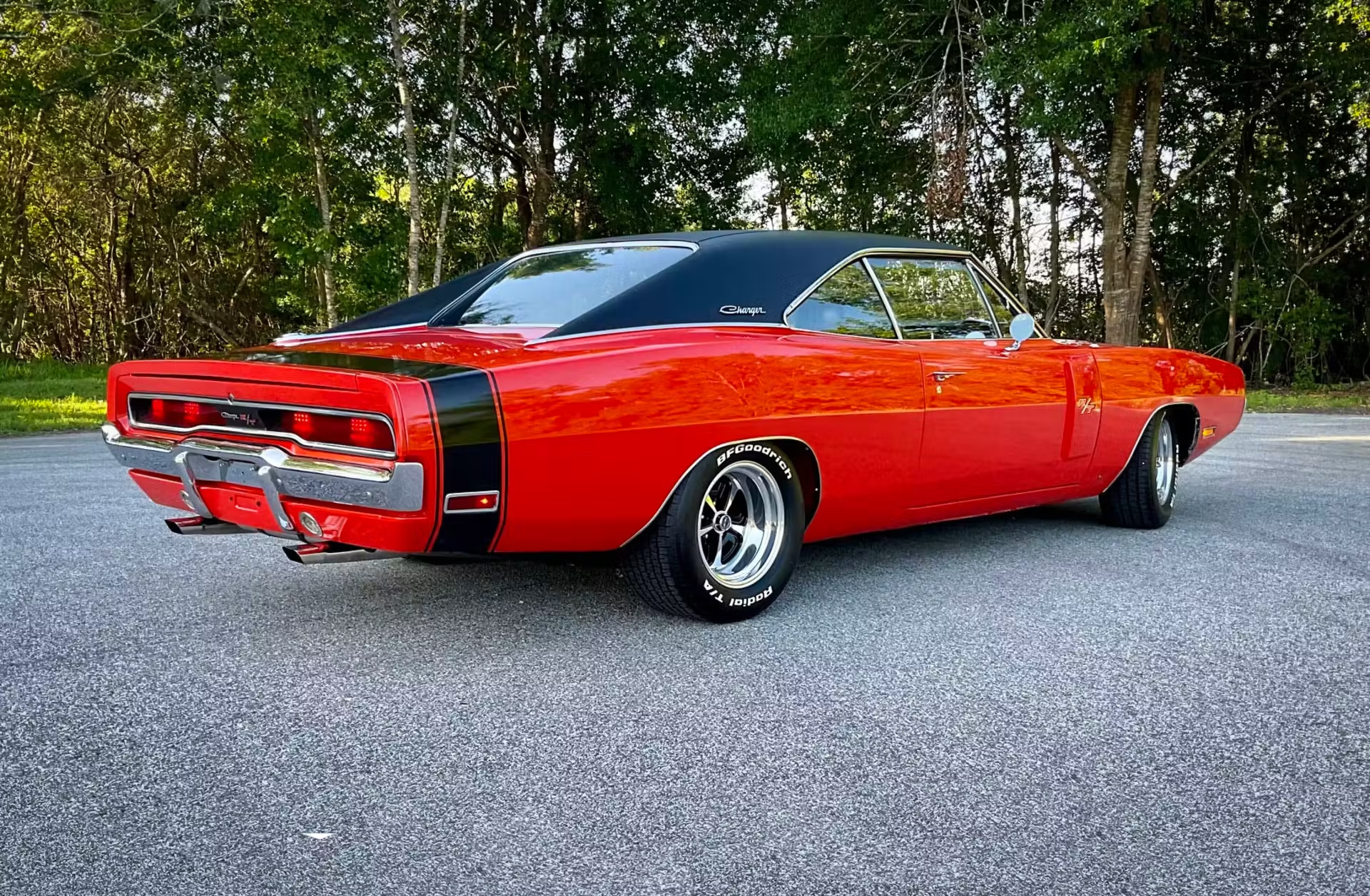Media | Articles
Dodge’s most beautiful muscle cars are still attainable
If you’ve ever watched auction broadcasts that show numbers-matching, perfectly restored muscle cars crossing a well-lit block before an ogling crowd, you might think that ’60s and ’70s metal is out of your reach. It’s true that the most desirable Mopars—typically, the rarest and most powerful configurations—bring eye-watering prices, which is also why those cars garner the most headlines and generate the loudest hype. However, plenty of curvaceous Chargers and Challengers deliver all the style and much of the V-8 soundtrack at attainable prices.
If you’re willing to opt for a small-block and add a four-barrel carburetor on your own, you’ll find that prices on some of Mopar’s most beautiful creations are surprisingly reasonable. In fact, some of the most tempting value propositions are found within Dodge’s most recognizable classic muscle cars: the 1970 Challenger and 1970 Charger.

Introduced in the fall of 1969, the 1970 Challenger was Dodge’s long overdue answer to the Ford Mustang and Chevrolet Camaro in the pony-car wars. (The Plymouth equivalent was the third-gen Barracuda.) Options were numerous and eight engines were available, from a humble slant-six to a range-topping 426 Hemi. Dodge also offered 22 paint colors, many of them bright “high impact” shades like Panther Pink and Top Banana, to distinguish its Challenger from the more established competition. About 83,000 were sold.
As for the Charger, it had been around since 1966 but matured in 1968 with a crisp, Coke-bottle redesign made famous in the Bullitt chase scene and on The Dukes of Hazzard. As the big news for 1970 was the Challenger, Dodge mostly left the ’70 Charger alone except for a few details, the most noticeable being a loop front bumper around a one-piece grille. Like the Challenger, engines ranged from small slant-six to monster V-8. Total production was nearly 50,000.

The 1970 model year was the first for the new Challenger and the last for the second-gen Charger, but as of 1971, both models started to lose their good looks and unencumbered horsepower. The style and speed of the ’70 models make them some of the most popular vintage muscle cars around. Their wide range of engines and options, meanwhile, allows for a huge spread in terms of price.
Marketplace
Buy and sell classics with confidence
Let’s look at some data. The models that garner the most attention and biggest bucks are, in the Charger’s case, the NASCAR homologation Daytonas, sculpted and winged for 200-mph superspeedways. But the magic word for either Charger or Challenger is “Hemi.” Recently, it seems that Mopar has had no problem selling 11,000 Hemis in a week, but the Gen II 426 “street Hemi” of old sold about that many in its entire six-year production run (1966–71). A real 426 Hemi car is a rare and welcome sight at any car show. With rarity, range-topping status, and serious racing credibility, these variants demand a serious premium.
Though several engine and trim options exist, we focused on two to illustrate accessible Mopar entry points. For those in the market for a weekend driver with the same gorgeous lines and many of the same options as those rare Hemi machines, the 318- and 440-powered models are still out there, in greater numbers and at much more affordable prices.

The two-barrel, 318-powered Challenger and Charger have seen a similar uptick in value as the 375-hp 440 cars have, but not nearly as large as that of the 426-powered models. We’re used to seeing rising prices of the most desirable trims and engines lead to rising prices across the model range. Typically, and as is the case with the Challenger, the more affordable models often see a less substantial increase.
The curvaceous lines of Mopar’s quintessential muscle car are favored over those of the Challenger, although five years ago the cars’ prices were virtually dead-even. Examples in #3 (Good) condition offer even more compelling value, with the Charger R/T 440 and base 318 coming in at $71,500 and $30,500, respectively. The Challenger follows suit, at $46,300 for the R/T 440 and $21,100 for the base 318.

As far as demographics, Gen X makes up a disproportionate share of quotes for the Charger, at 39 percent; the same cohort holds 32 percent of the overall collector-car market. Those interested in the Challenger, on the other hand, skew a bit older: Baby boomers account for 44 percent of the Challenger market despite comprising 34 percent of the overall market. The interest among younger buyers suggests that Charger values may have a slightly stronger future than those of the Challenger, but the difference between the two quote demographics is not dramatic.
If you’re in the market for one of these attainable two-doors, we must admit that a two-barrel 318 isn’t the most exciting powerplant. But if numbers-matching isn’t your thing, it’s never been easier to build a powerful yet streetable Mopar small-block or swap in a late-model Hemi.
Even if numbers-matching is your thing, that correct engine won’t mind if it sits on a stand while a rowdy 408 gets out to play on the weekend. It’s a well-known fact that even a mild, rebuilt 318 Charger or Challenger that gets driven sounds better, is more fun, and garners much more attention than a 426 Hemi that never leaves the garage.
***
Check out the Hagerty Media homepage so you don’t miss a single story, or better yet, bookmark it. To get our best stories delivered right to your inbox, subscribe to our newsletters.












Funny thing, back in the day the dodges and plymouths were yhe cheap alternative to 442’s, buick gs cars, Gto’s Torino’s etc,. Now its flipped so much the other way,. way over priced, like a 69 camaro or a chevelle. Add some badges for 25,000.
the odd/rare cars are more interesting than the conventionally popular in the past.
I prefer the Charger over the Challenger in terms of looks. But I can’t afford any of them.
What happened to the Mopar Curse?
How about the 71 cuda
For many years I owned and daily drove a 1970 Plymouth Sport Satellite. Although not mentioned in the article, it was of the same family to the Dodge of course. This model had the white buckets seats and fabulous trim, kind of a cross between the Road Runner and the GTX. It only had the stock 318. Over the years I added a 4barrel manifold and carb, along with headers and that’s about it. It looked great and sounded great and I loved it dearly. I was never bothered that it was “only” a 318! It was gorgeous, reliable, and fun….and I f***ing loved it. You don’t need a hemi to smile.
The article covers the 318 cars but overlooks the non-Magnum 383. The 383 four barrel is a strong performer and a lightly modified 383 two barrel will keep lots of people happy. Dodge sold a lot of Challengers and Chargers with these engines.
I’m late to the story but you should leave the peoples speed estimate alone. Back when the roads were clear you could get the 60s cars rolling well beyond the 120 max on your speedometer. I had Dads 69 Wildcat 430 pointing at D2. We were definitely floating 120+++. 155 was possible in those days. Don’t doubt the ability of the old man to remember what was.
The 1968-70 Chargers are still some of the most beautiful cars out there. I would not want a 318 (that is more suitable for the Dart), but a nice 383 would certainly satisfy.
I had my 2011 Lamborghini Gallardo LP560-4 Spyder up to 165mph on the PCH from Neptune’s Net to Trancas Canyon road Malibu, CA 3 times in a row during COVID 19. No one on the PCH heading South besides me and a new black Porsche 911 that I beat 3 times in a row. Even twice giving him the lead off and still whipped him. Scary, but fun. Lol!
Anyone doing 155 MPH in a 70’s Challenger is dreaming and watching the Vanishing Point !
I have been Mopar or no car since the late 60s but I am priced out now. I would like a 60 or 64 Fury to enjoy in my retirement but their either rusty junk or over restored.